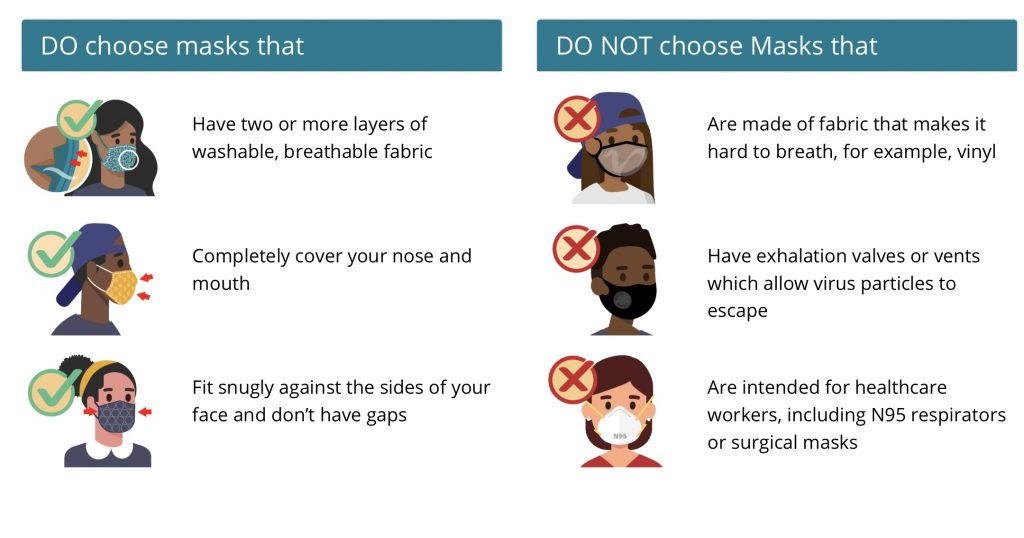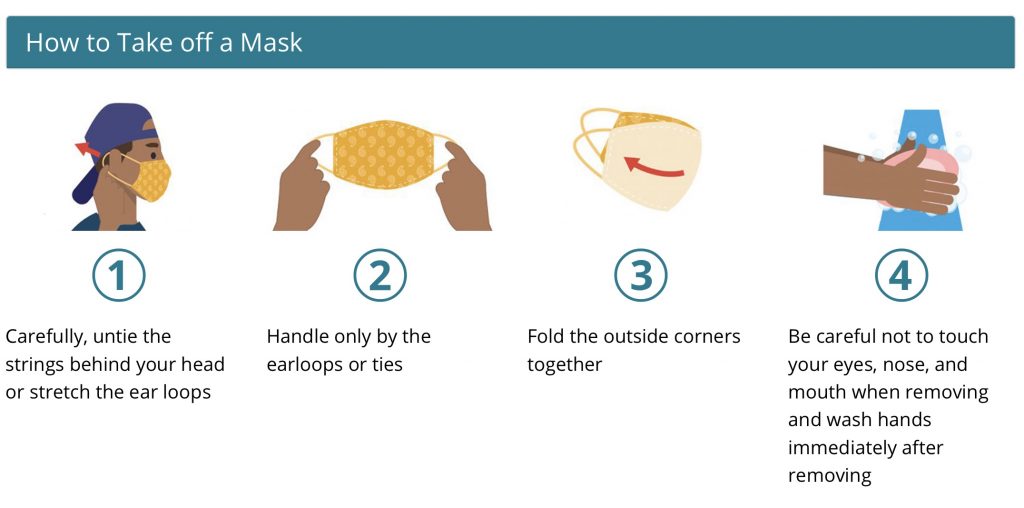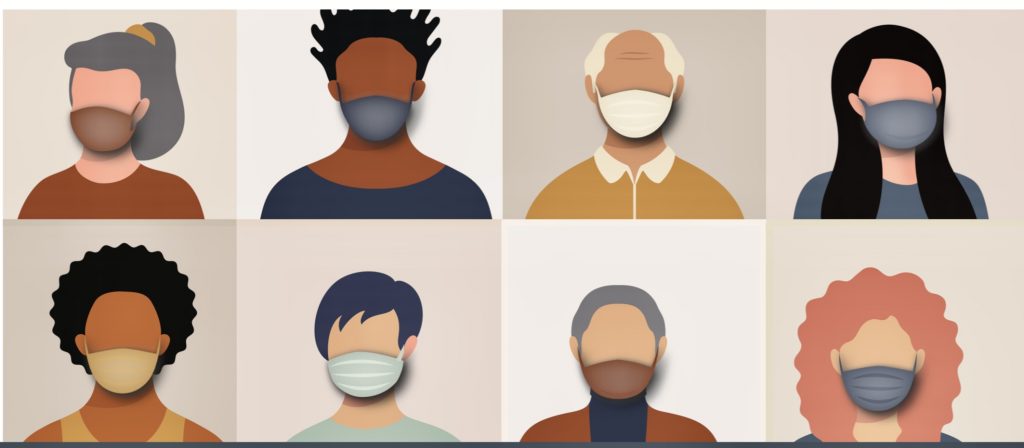Masks are key in the fight to stop the pandemic. And this guide provides useful information, tips and resources. And it in part uses tools from the Centers for Disease Control and Prevention (CDC). We have integrated this information with our own tools.
Even if you had the virus or received a vaccination, you still need to follow key prevention steps. And this includes wearing a mask when around others.
For those that received the vaccination: the CDC recommends that you still follow all prevention steps, including wearing a mask. And that is because experts need to learn more about the protection that COVID-19 vaccines provide under real-life conditions. Also other factors, including how many people get vaccinated, and how the virus is spreading in communities, will also affect their decision when to change this guidance.
The mask needs to cover your nose and mouth. Anyone who has trouble breathing or is unable to remove a mask without assistance should not wear one. Masks should not be worn by:
- Children younger than 2 years old
- Anyone who has trouble breathing
- Anyone who is unconscious, incapacitated, or otherwise unable to remove the mask without assistance
Selecting a Mask
When selecting a mask, there are many choices. And you need to find what works best for you. If you wear glasses, for example, make sure you select a mask that works with them. In this case, select a mask that fits close to the nose. Or that contains a nose wire, thus to avoid fogging.
Today, many masks are made for children. Parents should select one that fits their children comfortably. A mask should never be placed on a child under the age of 2. See below for details on guide on masks and school.
If you wear a gaiter, make sure it has two layers. Or alternatively, fold it so that it has two layers.
Last, a face shield is not a replacement for a mask. Do not wear one without a mask. It alone will not reduce the spread of the virus. And some are substituting it for a mask. This is a mistake.

Wearing a Mask Correctly
Wearing a mask correctly is key. It will help reduce the spread of the virus. It protects us. And it also protects other, too.

This short video made by the CDC demonstrates the proper methods to put on and take off a face mask:
Taking off a Mask correctly
It is not only important to wear the mask correctly, but to handle it correctly, too. Wash your hands after removing it. More, this is important to kill any virus particles attached to the mask. Here is an infographic from the CDC illustrating the correct steps:

Care for a Mask
Taking care of a mask is important also. And the CDC has several recommendations on caring for a mask.
Store your cloth mask properly and wash it regularly to keep it clean. Consider having more than one on hand so that you can easily replace a dirty mask with a clean one.
If your mask is wet or dirty, keep it in a sealed plastic bag until you can wash it. But wash as soon as possible to prevent them from becoming moldy. Wet masks can be hard to breathe through. And they offer less protection than dry ones.
You can store your mask temporarily to reuse later. Keep it in a dry, breathable bag (like a paper or mesh fabric bag) to keep it clean between uses. When reusing it, keep the same side facing out.
If you are taking it off to eat or drink, keep it safe and clean. More, make sure to wash or sanitize your hands after removing it. After eating, put it back on with the same side facing out. And then wash or sanitize your hands again.
Wash your cloth mask whenever it gets dirty or at least daily. If you have a disposable face mask, throw it away after wearing it once. You can wash cloth masks with your regular laundry. And you do not need to add any other additional ingredients nor do anything different. But also read the care instructions on the label, too.
You also can wash by hand. Make sure to use a detergent or soap. And then to rinse it thoroughly with clean water. Make sure that the detergent or soap is removed.
Dry your mask completely in a warm or hot dryer. Hang it in direct sunlight to dry completely. And if that is not an option, then hang it or lay it flat.

Masks and School
Wearing masks should be a priority for students. Especially if they will be close to others.
Children 2 years of age and older should wear a mask.
Help your child wear a mask correctly when in public and when around people they do not live with.
Note that wearing a mask is not a substitute for other everyday prevention actions, like avoiding close contact with others and washing hands frequently.
School Mask Prep
These are some key steps to consider in preparing for the new school year:
- Have multiple masks, so you can wash them daily and have back-ups ready. Choose masks that:
- Fit snugly but comfortably against the side of the face
- Completely cover the nose and mouth
- Are secured with ties or ear loops
- Include multiple layers of fabric
- Allow for breathing without restriction
- Can be washed and machine dried without damage or change to shape
- Practice with your child putting on and taking off masks without touching the cloth.
- Explain the importance of wearing a mask and how it protects other people from getting sick.
- Consider talking to your child about other people who may not be able to wear masks for medical reasons (e.g., asthma).
- As a family, model wearing them, especially when you are in situations where physical distancing is difficult to maintain.
- If you have a young child, help build their comfort wearing a mask and become comfortable seeing others in them.
- Praise your child for wearing a mask correctly.
- Put a mask on stuffed animals.
- Draw a mask on a favorite book character.
- Show images of other children wearing masks.
- Allow your child to choose their mask that meets any dress requirements their school may have.
- Suggestions from the American Academy of Pediatrics
Mask School Prep: Sending to School
These are tips to ensure that your child always is prepared:
- Consider providing your child with a container (e.g., labeled resealable bag) to bring to school to store their masks when not wearing it (e.g., when eating).
- Label your child’s masks clearly in a permanent marker.

Health Messages: Masks are Key
Masks are key. Wearing a mask is essential to halt the virus. It is one of the key steps we can all take.
Our mask efforts began in January, 2020. We have been promoting masks since.
We have identified three key messages to promote masks:
Masks are Key: They Telegraph a Key Health Message
A mask is a health message. Wearing one telegraphs an important health message. It reminds the person wearing it that the virus is serious. It also reminds others of the same message, too. Please set a positive example for others. And wear a mask.
Masks are Key: They Protect the Person Wearing the Mask
Masks protect us from the virus. This is key.
The Centers for Disease Control and Prevention has recently included this message in its publications.
Masks are Key: They protect others, too
Masks also protect others, too. It can be days before symptoms appear. Yet, you can still spread it. Also, some people carry the virus but never experience symptoms themselves.
Photograph by Narongpon Chaibot, other media by the Centers for Disease Control and Prevention

